#gotarzes
Explore tagged Tumblr posts
Text
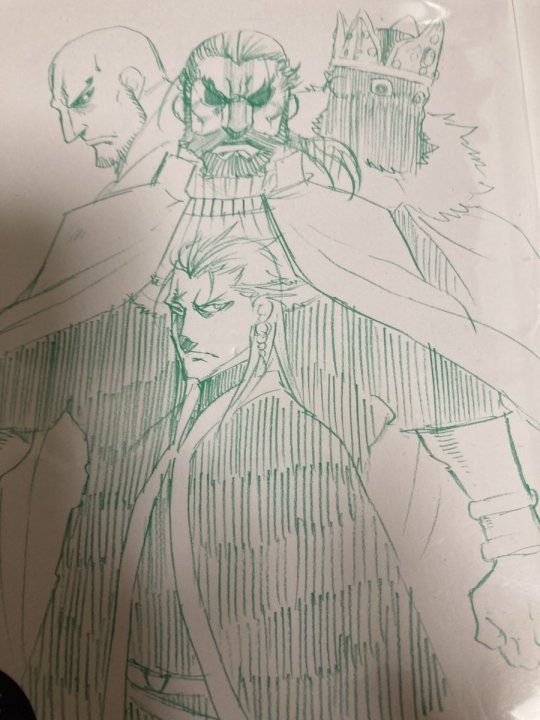
One of the bonus sketches from manga Vol. 21. Looks like there's another one too but I haven't managed to find a full image of it yet.
I really like this one, not only because I'm pleased to see Hilmes feature but because of the composition. The shadowy, mad-looking Gotarzes, whose mind was addled by the influence of sorcery. Osroes, whose eyes betray the inhuman decision he made about the child he raised as his son and pretended to love. Andragoras, with darkened eyes, looming over Hilmes in the foreground. Of them all, Hilmes is the only one whose eyes are clearly visible/drawn normally, and even then it feels symbolic that his right eye is partially obscured on his burned side.
The dark and bloody history of the Parsian royal family literally looming behind him, its mark left on his face. I hope he can break free of it.
#arslan senki#the heroic legend of arslan#hilmes#gotarzes#osroes#andragoras#Hilmes is very much a product of that history#but that doesn't mean he has to perpetuate it#and that's why I need him to relinquish the throne of Pars#he can find a way to heal with a different path
30 notes
·
View notes
Text
Okay, I want to dig into the whole 'sorcerers at court' thing (unsurprisingly it interests me!). I agree that over the years they have likely had a presence going back way further than Gotarzes, though how openly they involved themselves in matters or revealed their true nature was probably dependent on the attitude of the Shah at the time. I'm sure they've been pulling strings regarding the Parsian royal line for a long time, though.
As for when sorcerers etc stopped being a presence at court, I think their total absence came about when Andragoras took the throne, rather than Osroes being the one to drive them out. However, one notable exception is The Bastard Himself aka the Master. I highly doubt that Osroes would have tolerated his presence, given his involvement in what happened with his wife. Either Osroes got rid of him, or (more likely, in my opinion) the Bastard sensed when he wasn't wanted and deliberately made himself scarce. After all, his work at that time was done. He would have known that Andragoras's attitude towards sorcery etc would make it pointless to approach him, too, so at this time he went underground (probably literally given that it seems their base of operations is under Ecbatana itself). This is why Andragoras hasn't seen him since the time of Gotarzes — when he was still a visible presence at court.

(Panel above from Chapter 56).
While Osroes wasn't convinced that the prophecy regarding the royal line was true, he was still susceptible to the words of those purporting to have supernatural abilities, so he likely didn't clamp down on them anywhere near as hard as Andragoras did. The Master, referred to as 'the Great King's sorcerer,' had undoubtedly left the scene, but others still remained, for when Andragoras took the throne, he 'killed many prophets with unknown origins' (Book 7, Chapter 4, part ii). These may not have been affiliated with Team Zahhak, though!
With the Master himself no longer on the scene since Gotarzes's death, and Andragoras (presumably very visibly) getting rid of any other sorcerer/prophet types, I doubt anyone suspected they were involved with the palace fire in any way. Suspicions focused on Andragoras himself, and nobody believed Hilmes could have survived.
Osroes's supposed infertility is definitely up for debate. All we can say for sure is that he didn't father any children of his own. I certainly wouldn't put it past Team Zahhak to have arranged for that to be true. It seems they laid the groundwork for the prophecy regarding the royal line early on, by telling a young Gotarzes II that the line would end with his child, and then proceeding to build credibility in his eyes by arranged a series of events that appeared to prove their predictions were true. In this way, he was primed to believe it when the Master told him it was necessary to take Osroes's wife to his bed.
The prophecy is clearly a way for Team Zahhak to manipulate matters, but honestly, I can't say for sure that there's not an element of truth to it. It's not even clear in the novels. I certainly wouldn't believe everything the Master etc says, but there are some indications that in some cases, maybe he really can foresee things. The biggest example is a spoilery one that may not end up applying to Arakawa's manga adaptation, so I won't go into that here.
Tanaka writes about prophecy/the gift of foresight in the same way that he writes about the Parsian gods. The narrative implies that they exist, but no conclusive proof is given. I actually kind of like that approach.
Andragoras and Osroes actually had a good relationship before they fell out over Tahamenay. The novel states that 'as younger brother Andragoras was in full support of his older brother’s accession, Osroes succeeded the throne without incident.' Osroes even appointed his brother as Eran, giving him command of the entire army (Andragoras was definitely the more aggressive/militarily inclined of the two, which won him much support later when the relationship between the two soured). 'For two years the brothers successfully cooperated in upholding the legacies of their illustrious father,' until Andragoras asked for Tahamenay as his reward for annexing Badakhshan. (Quotes from Book One, Chapter 2, part iii)
Osroes was supposedly more inclined to obedience as a son than Andragoras was (presumably Andragoras would not have given in to a request to sent his wife to his father's bed) but they obviously were of a shared opinion when it came to Gotarzes in the end. Osroes must have known what Andragoras's thoughts regarding the supposed prophecy would be, as he likely knew how much he despised superstition. Given that the two had a good relationship at the time, it could be sympathy on Andragoras's face, but given the point their conversation has reached, perhaps he's more perturbed about what Osroes is implying they should do. After all, Andragoras does state that 'Osroes's zeal for the deed far outstripped [his] own'.
I wish we'd seen Isfan's diversion, too! Arslan's line of dialogue in the novels gives a bit more detail about what he did: "Isfan also helped a lot. He diverted the soldiers' attention by running towards another direction."
(For Wolfsnake AU I had been toying with the idea of him asking Gurgin to help him create a diversion!)
Arslan Senki Reread
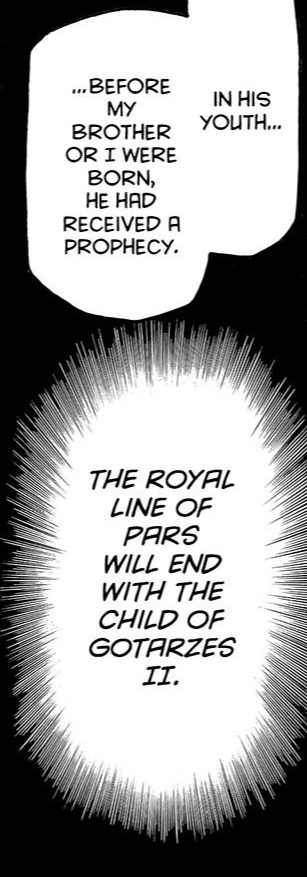
It starts out very early. I wonder when these sorcerers started becoming a presence in the royal court, if my hunch is right and they go way too far back (I mean, the royal line immediately turned on itself within a single generation, coincidence? mayhaps not).
When did they stop being a presence? Before the palace fire, definitely, I would guess, but did Osroes drive them out for being the catalyst that led Gotarzes to claim his bride? Imagine if they were present right up until Andragoras torched the palace, though. Hilmes, presumably dead, and the sorcerers just vanish overnight? That would be hella sus and since Andragoras seems to express no suspicion about it I'm guessing it didn't go down that way.
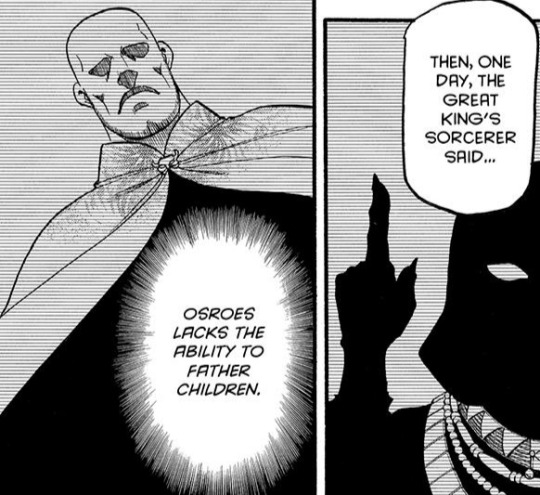
I don't believe they have true prophetic powers. I definitely have discussed this in an older post before, I'll see if I can dig that up, but I think it's all sleight of hand and manipulation and set-up to get people to believe them. That in turn was set-up for me to say: We can't know for sure if Osroes was actually infertile or not. If the sorcerer was manipulating scenarios to gain trust, why can we be certain this statement alone could be true? And even if it were true, I wouldn't be surprised if the sorcerers were the ones to make it true, aka, slip smth into Osroes on the sly, make him unable to sire children.

Andragoras here looks... sympathetic of his brother, almost sad, and it makes me wonder how close they were before they fell off? Did Andragoras rebel against Gotarzes, and resent Osroes for humoring their father? Did they form a tight bond of solidarity in response against Gotarzes' A+ parenting? Did they start bonding after this incident? Did Osroes only go to Andragoras who may have been taking an attitude against their father before, now that he can't take it anymore? Did he always? I remember they had a falling out over Tahamenay, was their bond already on so shaky a ground that they would feud over a woman? Okay, maybe that's an oversimplification of their conflict in that it's more than about Tahamenay it's also about Osroes breaking his promise and perhaps poking Andragoras' pride with that behavior but still...
What happened here?
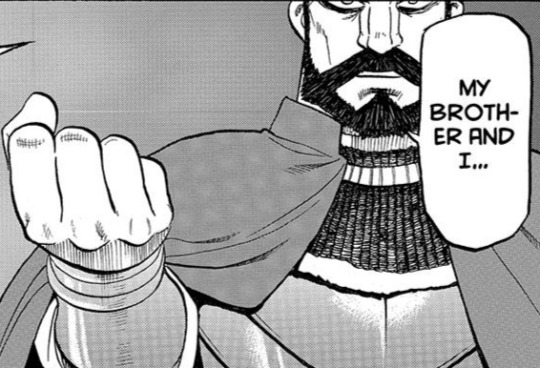
Oof, the framing of the panel making sure to feature his eyes but cutting off at a weird spot to make it look even more unsettling.
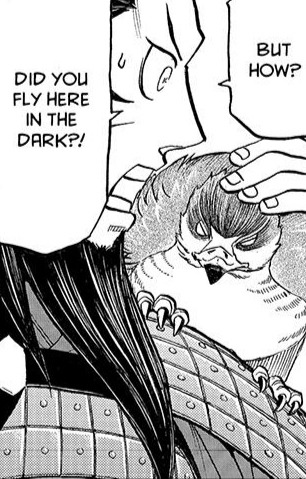
Yeah Azrael, how did you?

Tus and Isfan good 🥹 But aw, I wish we were shown a panel of Isfan causing a diversion. What did he do to mask their presence?

Everyone with an eye can see how cold and distant the dynamic is between Arslan and his “parents”.

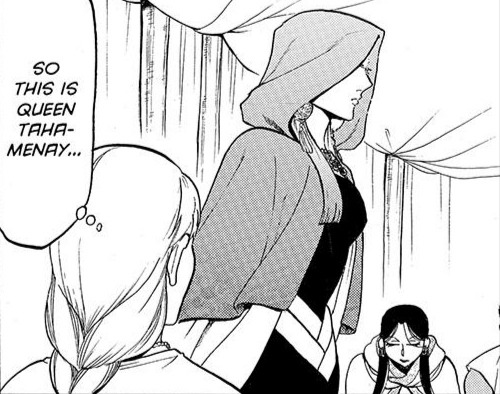
Kneeling, kneeling, I have thoughts regarding this reserved for a later entry.
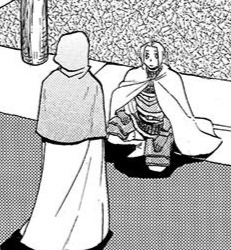
And Arslan remains kneeling through the entire conversation.
33 notes
·
View notes
Text
The Kingdom of Maar
Here is the lore post for Maar i pormised! It is only the history as I did go a bit overboard with literally everything lol. At least have this as I sort out the rest
(We love going overboard for Lore™)
WARNING: long post
HISTORY OF MAAR
What came when
people originated from Maryam
They searched for land in hopes of a better future and life
Water, not Land!
a small land in the Siyabun Sea becomes their new home
very slowly building homes at the coast and trying to grow differnt crops
creating a new faith so the people stick together (also found traces of ancient civilisation which they mix with the pagen religions from Maryam)
trying to resume their normal life with what they have
slowly building an army (ya know, just in case)
Hey, who wants wine?
finding fertile soil higher up
finding grapes and starting to grow them
make wine, discover demand and profit, selling time!
discover small amounts of metal (like iron, gold, copper,etc.) and start mining and smithing
Who the fuck?
tryed conversion/invasion by the Lucitanians
expanding the army into a small navy fleet
using self-made weapons and stopping the invasion
Lucitanians give up
destroied crops and some coastal villages due to the fight
needing to expand further into the mountains and higher up
Even more metal!!
through forced expantion discovered more raw metal in mountains
expantion of mining and usage of metal in every day life
finding more traces of ancient civilisation and starting to use the runic magic system
Come and get some!
establishing international trading and political and diplomatic bonds
great respons
Roundtrip
Eldar visits Pars for diplomatic discussions with Gotarzes
an accident happens
Eldar dies
Moja takes over until Farzin is old enough
Another expantion!
strenthening nayvel forces
expanding wine fields
New era of reign
marrige to Serrilda
Farzin succeeds the throne
new law that everyone can serve in the army
florishing international trade
What, again?
tryed invasion by Lucitania again
after they tried to invaed Maryam and where stoped by Pars
failed again (even worse than before)
Now
sending a small delegation to Pars
offer help against Lucitania
Andragoras refuses and sends them away
under the order of Farzin, they still help in the shadows
Later, form alliance with Arslan, which is even later revoked by Andragoras again
15 notes
·
View notes
Photo





÷
·
𒀭𒀀𒉣𒈾 ANUNNAKI ·
·
šakkanakki Bābili · King of Babylon ·
·
· ·
Sumu-abum
Sumu-la-El Sabium
Apil-Sin
Sin-Muballit Hammurabi
Samsu-iluna
Abi-Eshuh Ammi-Ditana
Ammi-Saduqa Samsu-Ditana
Dynasty I · Amorite · 1894–1595 BC
. .
.
Ilum-ma-ili Itti-ili-nibi
Damqi-ilishu
Ishkibal Shushushi
Gulkishar
DIŠ-U-EN Peshgaldaramesh
Ayadaragalama
Akurduana Melamkurkurra
Ea-gamil
Dynasty II · 1st Sealand · 1725–1475 BC
·
· ·
· ·
Gandash
Agum I Kashtiliash I
Abi-Rattash Kashtiliash II
Urzigurumash
Agum II Harba-Shipak
Shipta'ulzi
Burnaburiash I Ulamburiash
Kashtiliash III
Agum III
Kadashman-Sah
Karaindash Kadashman-Harbe I
Kurigalzu I
Kadashman-Enlil I Burnaburiash II
Kara-hardash
Nazi-Bugash Kurigalzu II
Nazi-Maruttash
Kadashman-Turgu Kadashman-Enlil II
Kudur-Enlil
Shagarakti-Shuriash Kashtiliash IV
Enlil-nadin-shumi
Kadashman-Harbe II Adad-shuma-iddina
Adad-shuma-usur
Meli-Shipak
Marduk-apla-iddina I
Zababa-shuma-iddin
Enlil-nadin-ahi
Dynasty III · Kassite · 1729–1155 BC
. .
.
·
· ·
Marduk-kabit-ahheshu
Itti-Marduk-balatu Ninurta-nadin-shumi
Nebuchadnezzar I
Enlil-nadin-apli Marduk-nadin-ahhe
Marduk-shapik-zeri Adad-apla-iddina
Marduk-ahhe-eriba Marduk-zer-X
Nabu-shum-libur
Dynasty IV · 2nd Isin · 1153–1022 BC
· ·
· ·
·
Simbar-shipak
Ea-mukin-zeri Kashshu-nadin-ahi
.
Dynasty V · 2nd Sealand · 1021–1001 BC
· ·
· ·
Eulmash-shakin-shumi Ninurta-kudurri-usur I
Shirikti-shuqamuna
Dynasty VI · Bazi · 1000–981 BC
·
· ·
·
Mar-biti-apla-usur
Dynasty VII · Elamite · 980–975 BC
·
· ·
·
· ·
Nabu-mukin-apli Ninurta-kudurri-usur II
Mar-biti-ahhe-iddina Shamash-mudammiq
Nabu-shuma-ukin I Nabu-apla-iddina
Marduk-zakir-shumi I Marduk-balassu-iqbi
�� Baba-aha-iddina
.
.
.
at least 4 years
Babylonian interregnum
Ninurta-apla-X Marduk-bel-zeri
Marduk-apla-usur Eriba-Marduk
Nabu-shuma-ishkun Nabonassar
Nabu-nadin-zeri Nabu-shuma-ukin II
Dynasty VIII · E · 974–732 BC
· ·
·
·
·
Nabu-mukin-zeri Tiglath-Pileser III
Shalmaneser V Marduk-apla-iddina II
Sargon II Sennacherib
Marduk-zakir-shumi II Marduk-apla-iddina II
Bel-ibni Aššur-nādin-šumi
Nergal-ushezib Mushezib-Marduk
Sennacherib aka Sîn-ahhe-erība
Esarhaddon aka Aššur-aḫa-iddina
Ashurbanipal
Šamaš-šuma-ukin
Aššur-bāni-apli Sîn-šumu-līšir
Sîn-šar-iškun
Dynasty IX · Assyrian · 732–626 BC
. .
.
.
Nabopolassar
Nabû-apla-uṣur
Nebuchadnezzar II Nabû-kudurri-uṣur
Amēl-Marduk
Neriglissar
Nergal-šar-uṣur
Lâbâši-Marduk
Nabonidus
Nabû-naʾid
Dynasty X · Chaldean · 626–539 BC
. ·
. ·
. ·
. ·
. ·
. ·
Cyrus II the Great · Kuraš · 𐎤𐎢𐎽𐎢𐏁 Kūruš ·
Cambyses II · Kambuzīa ·
Bardiya · Barzia ·
Nebuchadnezzar III · Nabû-kudurri-uṣur ·
·
Darius I the Great · Dariamuš · 1st reign
·
Nebuchadnezzar IV · Nabû-kudurri-uṣur
Darius I the Great · Dariamuš · 2nd reign
·
Xerxes I the Great · Aḫšiaršu · 1st reign
·
Shamash-eriba · Šamaš-eriba
Bel-shimanni · Bêl-šimânni
·
Xerxes I the Great · Aḫšiaršu · 2nd reign
·
Artaxerxes I · Artakšatsu
Xerxes II
Sogdianus
Darius II
Artaxerxes II
Artaxerxes III
Artaxerxes IV
Nidin-Bel
Darius III
Babylon under foreign rule · 539 BC – AD 224
Dynasty XI · Achaemenid · 539–331 BC
·. ·
·. ·
·. ·
·. ·
·. ·
·.
Alexander III the Great · Aliksandar
Philip III Arrhidaeus · Pilipsu
Antigonus I Monophthalmus · Antigunusu
Alexander IV · Aliksandar
Dynasty XII · Argead · 331–305 BC
·.
·.
·.
·.
·.
Seleucus I Nicator · Siluku
Antiochus I Soter · Antiʾukusu
Seleucus · Siluku
Antiochus II Theos · Antiʾukusu
Seleucus II Callinicus · Siluku
Seleucus III Ceraunus ·
Antiochus III the Great · Antiʾukusu
Antiochus ·
Seleucus IV Philopator · Siluku
Antiochus IV Epiphanes ·
Antiochus
Antiochus V Eupator
Demetrius I Soter
Timarchus
Demetrius I Soter
Alexander Balas
Demetrius II Nicator
Dynasty XIII · Seleucid · 305–141 BC
· ·.
. · ·
. · ·
. · ·
· ·.
· ·.
Mithridates I
Phraates II
Rinnu
Antiochus VII Sidetes
Phraates II
Ubulna
Hyspaosines
Artabanus I
Mithridates II
Gotarzes I
Asi'abatar
Orodes I
Ispubarza
Sinatruces
Phraates III
Piriustana
Teleuniqe
Orodes II
Phraates IV
Phraates V
Orodes III
Vonones I
Artabanus II
Vardanes I
Gotarzes II
Vonones II
Vologases I
Pacorus II
Artabanus III
Osroes I
Vologases III
Parthamaspates
Vologases IV
Vologases V
Vologases VI
Artabanus IV
Dynasty XIV · Arsacid · 141 BC – AD 224
· 9 centuries of Persian Empires · until AD 650
Trajan in AD 116
mid-7th-century Muslim Empire
·.
·.
·.
1921 Iraqi State
·.
·.
1978 · 14th of February · Saddam Hussein
·.
·.
2009 · May · the provincial government of Babil
·.
·.
·.
·.
. ·
·.
·.
·.
·.
so many kings
and just one queen
semiramis
·· ·
· SEMIRAMIS ·
··
.
.
.
.
···· Βαβυλών ··· ΒΑΒΥΛΩΝ ····
Babylonia
Gate of the Gods
بابل Babil 𒆍𒀭𒊏𒆠 · 𒆍𒀭𒊏𒆠 · 𐡁𐡁𐡋 · ܒܒܠ · בָּבֶל
Iraq · 55 miles south of Baghdad
near the lower Euphrates river
.
.
.
.
.
#king#of#babylon#semiramis#assur#uruk#mar-biti-apla-usur#marduk-apla-usur#mesopotamia#annunaki#anunnaki
6 notes
·
View notes
Photo
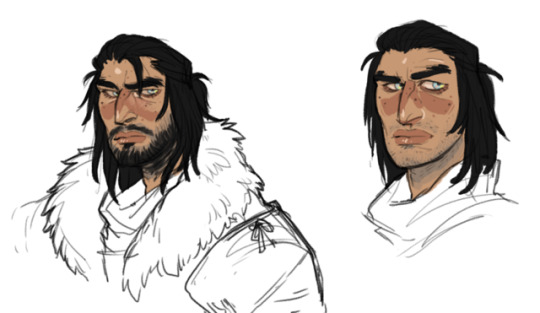
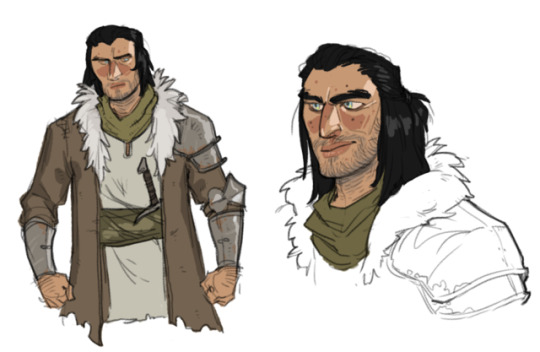
Some slightly older art I’ve neglected to post up
24 notes
·
View notes
Text

Silver drachm from the reign of Gotarzes II, Parthian (Iran), 40-51 AD
from Timeline Auctions
424 notes
·
View notes
Photo

[DISCOUNT] $44.25 Ancient Parthian Coin/Gotarzes or Sinatruces/Ecbatana/Horned Tiara/Stags/Archer BUY NOW! #AntiqueGreekCoins, #AncientGreekCoins, #OldGreekCoins
1 note
·
View note
Photo

Other quests open in the sixth sequence of the plot after completing the pirate quests and rescuing the Gotarzes brother from the robbers on Lestris Island, the task “Whoever finds, takes it for himself”. The player, arriving earlier, hears the words of Xenia: “Good luck in the search”, thereby the personal storyline does not start. To gain the confidence of the pirates, Ksenia gives the first task. Then, in order to twist the novel and open the achievement “Embrace of Aphrodite”, you can select replicas marked with hearts in a conversation with Ksenia.
Read more: https://gamers-buzz.com/assassins-creed-pirate-life-for-me/
0 notes
Text
GUEST MUSE XENIA - BIOGRAPHY:
- Speculated biracial Persian and Greek heritage based on the the name of her younger brother - Gotarzes (from the name Gōtarz which is Parthian)
Years active as a pirate: 11 years - 431 - 422 BCE
She began life as a captain and soon after went into pirating for a way of making independent income. Before the beginning of the Polyponessian war, Phoenix joined her and sailed at her side for a while - both being excellent pirates and close friends, even if the other woman became more engrossed with politics. She was greatly saddened when Phoenix left.
During the Polyponessian war, she landed on Keos and overtook the town of Koressia as their own pirate land - now forging local skirmishes with the Athenian archon of the island. There she met Kassandra whom she hired to locate great treasures and gave information of Phoenix to.
0 notes
Link
This article analyzes the techniques by which the kings of the early Sasanian dynasty engaged the past and shaped the experience of future generations. I concentrate on the innovations and legacy of the first two kings of kings of the dynasty, Ardashir I (r. 224–239/40 C.E.) and his son Shapur I (239/40–270/2 C.E.). These sovereigns fashioned a new and politically useful vision of the past to establish their dynasty's primacy in Persia and the wider Iranian world, eclipsing their Seleucid, Fratarakid, and Arsacid predecessors. I identify and examine the artistic, architectural, and ritual means by which the early Sasanians conformed the built and natural environment of their homeland to their grand new vision of the past. I argue that the Achaemenid patrimony of the province of Pars played an important role in these efforts, serving as inspirations and anchors for the Sasanians' new creations.
Matthew P. Canepa. "Technologies of Memory in Early Sasanian Iran: Achaemenid Sites and Sasanian Identity." American Journal of Archaeology, Vol. 114, No. 4 (October 2010), pp. 563-596.
The Sasanian dynasty had its roots in the province of Pars in southwestern Iran, the homeland of the Achaemenid empire (fig. I).10 Although their empire had been defunct for centuries, the ruined palaces, sacred sites, and tombs of the Achaemenid kings of kings still loomed large on the physical and ideological horizons of Pars long after their fall. The vestiges of this great, yet half-understood, Persian heritage confronted all who held power in the province and eventually stimulated the Sasanians' own memorial and monumental practices. The most impressive concentration of visible Achaemenid remains in Pars lay at the western end of the Marv Dasht plain. Here, the plain meets the mountains, and the Polvar River divides the mountains into two spurs, the Hosayn Kuh to the north and the Kuh-e Rahmat to the south. Persepolis' massive platform rose below Kuh-e Rahmat, while, about 6.25 km to the north, the Achaemenids' royal necropolis, called today by its New Persian nickname of Naqsh-Rostam, marked the final spur of the Hosayn Kuh. Be tween these two ancient sites grew Staxr, post-Achae menid Pars' principle city and religious center.11 From at least the early Sasanian period, the inhabitants Pars conceived of Staxr, Persepolis, and Naqsh-e Ros tam as a whole.12 With their colossal architecture and fine relief sculpture, Persepolis and Naqsh-e Rostam emerged as objects of special pride and fascination for the post-Achaemenid rulers of Pars and, eventually, became the raw material out of which the Sasanians crafted their early expressions.13
While they presented themselves as the true stewards of the ancient Persian sites, the Sasanians' memo rial activities owed a great deal to their more proximate predecessors in the region. Indeed, the Sasanians initially drew from, and reacted to, the accumulated Hellenistic, Arsacid, and local post-Achaemenid Persian reinterpretations of the sites. After entering Parsa in 331 B.C.E., Alexander held victory games and banquet at Persepolis, a celebration that culminated in the destruction of the palace.14 While, in this instance, Persepolis served as a monument to Hellenic vengeance, other Achaemenid structures retained their original significance. Alexander made a show of caring for the Tomb of Cyrus to associate himself with the founder of the Achaemenid dynasty.15 Persepolis' significance as an aggressive, Macedonian victory monument did not endure long after Alexander's death. Despite its damaged state, the multivalent symbolic potential of the site attracted Alexander's successors quickly thereafter for different goals (see table 2). In 316, Peukestas, Alexander's companion whom he had appointed governor of Parsa, staged an elaborate banquet for his army at Persepolis before the showdown between Eumenes and Antigonos Monophthalmos, where he conducted lavish sacrifices to Alexander and Philip.16 The banquet hosted both Macedonian and Iranian contingents, and its seating arrangements and sacrifices evoke Persian protocol.17 This suggests that Peukestas, popular and trusted among the Persian nobility, intended to capitalize on Persepolis as an open-ended symbol that could speak to the event's different constituencies.18
[...]
In addition to their regalia, the Fratarakids incorpo rated into their coins aspects of the most prominent features of Achaemenid royal architecture and architectural ornament that still existed around them.28 Most of the Fratarakid coins depict a winged disk with a male bust emerging from it, recognizable on every Achaemenid royal tomb, many prominent reliefs at Persepolis, and many seals (fig. 2).29 On most issues, this divine figure hovers over a stepped rectangular structure with coffering or coffered doors that recalls Achaemenid architectural forms and post-Achae menid crenellations at Persepolis. Speculations on the identity of the structure on the reverses of the coins have proliferated; however, the most cogent interpretation of the iconography, not to mention the only one grounded in primary source material (i.e., archaeological evidence), argues that it was inspired by Achaemenid architecture, possibly the Achaemenid towers such as were built at Naqsh-e Rostam and Pasar gadae.30 Although we will likely never know the exact function or identity of the structure, on most issues, a male figure stands next to it in a posture directly in spired by the composition and posture of the Achaemenid kings of kings on their tombs: the figures face right, raising their right hand to the winged figure above. The figures hold their bow with the bowstring facing away from the object of veneration. This is the same posture of respect shown by the Achaemenid sovereigns on the tomb reliefs. The bow, however, is of a contemporary, recurve style, rather than a direct copy of those on the Achaemenid reliefs.31
A discrete break with early Fratarakid coin types occurs only after Pars submitted to the Arsacids.32 The coinage of Wadfradad II, the first ruler of Pars thought to acknowledge Arsacid suzerainty, marks a transition, and after Darew II, the obverse portraits clearly follow Arsacid royal iconography.33 The reverse types change as well but do not follow Arsacid models. Achaemenid iconography appears also to have inspired these new types. The reverses of most of these portray a male figure in profile, facing a fire altar broadly similar to the fire altars on all Achaemenid tombs and many of the seals.34
The Fratarakids built both on and near the plat form of Persepolis. A group of structures located 300 m north of the platform show characteristics of a palace and a shrine where the inhabitants honored the gods with a statue, a fire, or some combination thereof.35 These post-Achaemenid mudbrick structures employed some carefully chosen and reworked Achaemenid stone architectural members, such as a doorjamb and lintel, all taken from material at Perse polis.36 The Fratarakids removed a doorway from the tacara (private palace) of Darius I. With its depictions of beardless eunuch servants in profile wearing Persian robes and carrying personal articles of the king (as in other relief sculpture there), incorporated into its new context, it is possible the Fratarakids gave these figures a new interpretation or identity. A windowjamb associated archaeologically with the sacred area of the complex carries the simple, low-relief images of two figures in profile. They hold ritual paraphernalia in their hands in a contemporary Middle Iranian gesture of reverence.37 The window that the jamb decorated communicated with the antechamber to the inner sacred area, linking their actions to the sacred area inside.38 Although they were Fratarakid creations, the iconography on these reliefs responds to and reinterprets aspects of the Achaemenid reliefs, adapting their striding profile and outstretched, raised arms to contemporary post-Achaemenid, Persian visual culture. If Islamic accounts can be believed, the Temple of Anahid in Staxr, of which the Sasanians took over the hereditary priesthood, similarly integrated elements of Achaemenid architecture such as bull capitals and reliefs.39
More remarkable for their absence, the Arsacids apparently never sponsored any activity in the Achaemenid ruins of the province, nor did they carve a rock relief in Pars near the Achaemenid tombs. Arsacid kings appeared in monuments in other provinces in their empire, such as the rock relief of Mithridates I at Khong-e Nowruzi, deep in Elymais.40 One can conjecture that this dearth of Arsacid evidence in Pars is the result of the Sasanians' particularly thorough job of obliterating their monuments, as occurred at Bisotun, or simply because by this time, Persepolis and Naqsh-e Rostam no longer held any special significance beyond the province. Bisotun, the site of Darius I's monumental rock relief and inscription, preserves limited evidence of Arsacid engagement with the Achaemenid site. Al though they do not match the scale or intricacy of the Sasanian material in Pars, Mithridates II, Gotarzes II, and a king named Vologases carved reliefs several meters distant, on Bisotun's lower rock face or in the field to the north, though, given their orientation, these were intended to engage with Bisotun's walled sanctuary below rather than with Darius I's relief.41
[...]
The founder of the Sasanian empire, Ardashir I, led his family's rise from obscure, local garrison commanders to provincial kings by systematically assassinating neighboring chieftains and annexing their domains.42 The family overthrew the king of Pars in 212 C.E., setting up an eventual conflict with the Arsacid king of kings, Ardawan IV. During the Sasanians' bloody two-decade rise from local dynasts to kings of kings, Pars' monumental patrimony again played an important role as raw material for expressing a vision of Iranian kingship for a new regime. Once in power, the Sasanians took possession of Staxr and its surrounding symbolic landscape, being driven to match and supercede their predecessors' engagement with the Achaemenid structures.
3 notes
·
View notes
Text
GOTARZES II 49AD PARTHIAN Ancient Tetradrachm Greek Coin of Parthia NGC i64321
GOTARZES II 49AD PARTHIAN Ancient Tetradrachm Greek Coin of Parthia NGC i64321
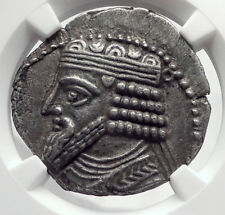
See it here here: http://www.ebay.com/itm/GOTARZES-II-49AD-PARTHIAN-Ancient-Tetradrachm-Greek-Coin-of-Parthia-NGC-i64321-/232505817217?hash=item36226d3881:g:Q6kAAOSwFhFZzmOV
eBay Store: http://stores.ebay.com/Authentic-Ancient-Greek-Roman-Coins
eBay Feedback
Educational Videos about ancient coin collecting and investing here: https://www.youtube.com/playlist?list=PL3dOqeLcLHYna6jl4_W5brq7ydWkewBdv
SUBSCRIBE to my YouTube channel: https://www.youtube.com/user/trustedancientcoins
Articles and Videos about ancient coins
Other Social Media Profiles and Sites
Twitter
Google+
Facebook
Every Item Comes with a Lifetime Guarantee of Authenticity and Individually Numbered Certificate of Authenticity

Own a piece of history today, guaranteed!

POST BY: Mr. Ilya Zlobin, world-renowned expert numismatist, enthusiast, author and dealer of authentic ancient Greek, ancient Roman, ancient Byzantine, biblical world coins & more.
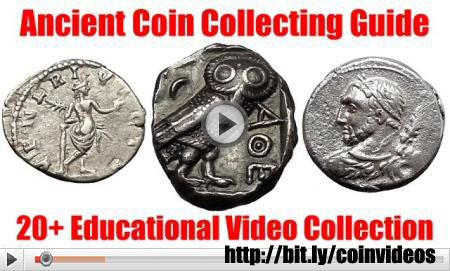
https://www.youtube.com/watch?v=_OghpYB823Q&list=PL3dOqeLcLHYna6jl4_W5brq7ydWkewBdv

September 29, 2017 at 06:17AM from Ancient Coin Investing and Collecting www.trustedcoins.com - Feed http://www.ancientcoininvesting.com/2017/09/29/gotarzes-ii-49ad-parthian-ancient-tetradrachm-greek-coin-of-parthia-ngc-i64321/ via http://www.ancientcoininvesting.com
0 notes
Text
Arslan Senki Chapter 124
I've cooled off a little bit after the intense experience that this chapter was, so here are a few thoughts! (I read the official simulpub on Kmanga, apologies that I haven't looked for the raw this time but it may be out there if you check.)
The chapter opens in the underground waterways and I am immediately relieved because this means that we did indeed backtrack a bit from last chapter, meaning that we are going to see the fighting there that reveals exactly how Andragoras reached Hilmes
Sam, when speaking of the existence of these tunnels, saying that if he'd known about them he wouldn't have 'helplessly surrendered the royal capital to the Lusitanian army'. Sam, please don't blame yourself! If the royal family chose to keep that knowledge to themselves, it's their fault, not yours. The fact that he's still blaming himself for this... That he thinks of himself as a failure in this respect... 😭
The Kishward-Sam fight was less nervewracking than the one the anime included in the battle for the Keep of Saint-Emmanuel, but only because I didn't know the outcome then. I think it's hard to get some of the nuances of this fight across in manga format but as usual Arakawa did a good job with it, and I want to discuss it a bit!

Sam's eyes here... He looks so sad, you just know he longed for that to have been him instead of leading the life he's living now
...and with that expression, the fight resumes. Kishward has already come to the conclusion that what Kubard said about Sam looking for death was true, and that's what we see when Sam next attacks, right after this line about envying Shapur and Garshasp. It's obvious that he's trying to force Kishward into a position where he has to kill him. He won't surrender, he won't switch sides, but he is willing to die like the warrior he no longer sees himself as.
If Kishward met him as he would someone he sees as a true enemy, he would have killed Sam then. He could have done so with his other sword while Sam is open after that strike. But he doesn't, because he doesn't want to kill his former comrade!
And Sam IS NOT WILLING TO KILL KISHWARD EITHER. If he had, Kishward would surely already be dead for what looks like seeking only to stand firm rather than land a fatal blow of his own, and that's why he only receives a broken sword and a shallow cut to the face. The... choreography (?) of the fight at this point is slightly different in the novels but I think the manga did a good job making a small change to show both of their attitudes more clearly.
(For the curious, in the novel Kishward's sword breaks on Sam's armour when Sam deliberately doesn't evade his slash, but as Kishward never intended for it to be a killing blow, it only cracks his armour. I'm not sure that would have come across from images alone so thumbs up to Arakawa for her modification.)
Sam still calling Andragoras 'Your Majesty' showing his inner conflict (Hilmes would hate it just as he did when Sam said 'His Highness Arslan' in his presence, but I find it understandable) but HE STILL DEFENDS HIS POSITION
and this is another small change from the novel but Arakawa's Sam is much more vehement here, much firmer in his conviction to not let Andragoras past and I love that because I can't deny it bothered me a bit in the novel scene where there's a lot of hesitance in his dialogue and he just says "Even though it's Your Majesty...' but here we get THIS:
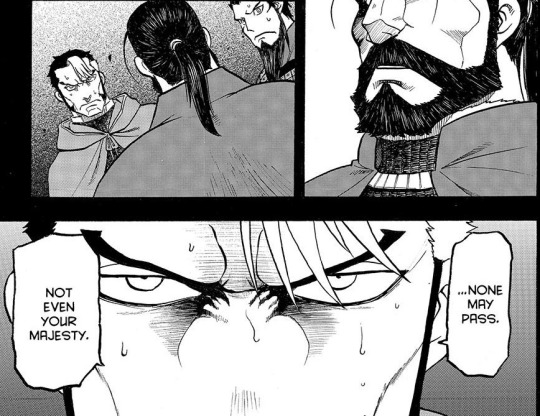
And if that doesn't confirm that despite any inner conflict he feels, he will never betray Hilmes for Andragoras, I don't know what does. So I was thrilled to see this, honestly.
In the novel it feels as though it's Andragoras's imposing presence that oppresses Sam's will to resist him but that's not so here. I can only believe that Sam allows him through precisely because he wants to avoid the situation he mentioned earlier; 'more slaughter between kinsmen.' If Hilmes and Andragoras talk, will fighting between Parsians be averted? This must be his hope. I do wonder whether he ends up having his suspicions about precisely what Andragoras wanted to tell Hilmes, though... after all, he already knows part of it himself.
(I had some mixed feelings about this moment, so I did quite a lot of thinking about it before, but honestly, it makes sense for Sam's character and what we know is important to him. I'm just very, very glad Arakawa allowed him to face Andragoras down like that first. I do wonder how Hilmes would see things, though.)
Anyway Hilmes's expressions in the following scene wrecked me and just watching him sweat and tremble in position and be on the verge of vomiting was hard. Anyway, the sordid details come to light, and we know who the sorcerer who supplied Gotarzes with the prophecy that caused all of it was...

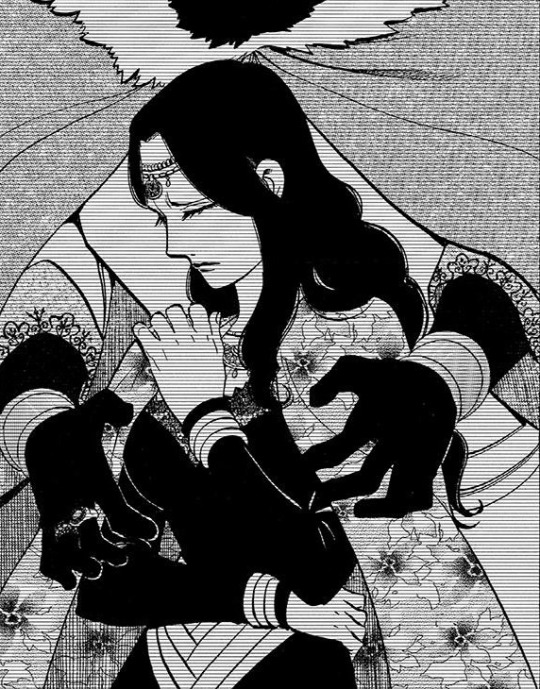
Some more images of Hilmes's (very beautiful) mother!
Gotarzes, though... The way he's drawn when he's grasping Osroes's wife shows how repulsive his decision was, and it's clear she doesn't want this, but she would have had no choice.
Hilmes tries so hard to believe that this is all a lie, but... you can tell that he can't. It's difficult to watch him go through this. And I can't believe we didn't even conclude this scene (unless Andragoras is just going to leave now in the manga; he didn't in the novels but we'll see, moving things around here could work but equally splitting it with the parallel conversation between Arslan and Tahamenay is a nice touch and I'm glad Arakawa is devoting the necessary time and attention to all of this).
You know... I'm exhausted lmao, someone else please post about the Team Arslan section that came after this.
#arslan senki#the heroic legend of arslan#arslan senki spoilers#sam#kishward#andragoras#hilmes#osroes#gotarzes#hilmes's mother#(maybe i didn't tag her before but she deserves her own tag)#it's my birthday today and the unexpected Shapur glimpse was a perfect gift
39 notes
·
View notes
Text
Yep, this was my assumption, too.
It fits for Tanaka to be deliberate about his name choice in this way. At a guess, he didn't wish to simply go with Fereydun because ArSen's mythology is not identical the myth presented in the Shahnameh, in the same way that Pars, while being heavily based on Persia, is a fictional fantasy version of it that doesn't match up exactly with the real geography, language, culture etc.
While many of ArSen's Parsian names are taken from/inspired by figures from the Shahnameh, they do also draw on other sources including history (the first fan translation notes the themes for Parsian names as including 'Shahnameh, Avesta, Assyria, Parthian/Arsacid Empire, Sassanian Empire, tiny bit of Achaemenid Empire, but also a lot of miscellaneous stuff'). In any case, the history of the Sasanian era is covered in the Shahnameh too.
Choosing Kaykhusraw as the name of the founder of the Parsian royal family and the one who defeated Zahhak gives a sense of him as both a mythical figure and a great ruler. In short, I'd be more surprised if this wasn't intentional on Tanaka's part!
The interview with Arakawa that you mentioned in the tags is (I believe) the one included in translated form in Vol. 1 of the manga. Here's the relevant section:

So, she mentions the Sasanian Empire rather than directly saying she based Pars on it, but I believe it's the case with the novels as well that the primary source of inspiration appears to be from this time. And I imagine that in terms of surviving artifacts etc that Arakawa on in her research (she mentions browsing museum catalogue images) a large proportion must have been Sasanian as it was the most recent.
In fact, probably the most convincing piece of evidence for Khosrow I being an inspiration for Tanaka's name choice of Kaykhusraw is the fact that the names of the Parsian royal family tree consist largely of Sasanian kings!
In terms of epithets for Parsian kings (just sort of jumping off your mentioned headcanon here but going a bit sideways I guess) there are some examples in canon. We have the Great King or King of Kings for Gotarzes, which presumably was inspired by the term Shahanshah even if Tanaka didn't include a Parsian term for it. Jahangir ('conqueror of the world') is used for Kaykhusraw (see the lyrics of the song Gieve plays before Tahamenay in the anime and manga, and the Epigraph from Book 2 of the original novel series). Plus the obvious Sage King (Jamshid) and Hero King (Kaykhusraw). But yeah, I like the idea that linguistically the word for 'royalty' could have its root in Kaykhusraw's own name. And the phrase 'royal blood' would inherently contain the implication of it being Kaykhusraw's blood. Nice.
I'm rambling a bit now but the Anushirvan epithet for Khosrow interests me in that I kind of feel like it might be the source for the name of the hill where the royal tombs are located in ArSen. It's not quite a match (from memory, the Chinese version gave it as something like 'Anushirak' but the original Japanese, 'アンヒラーク', is more like 'Anhirak'). Anushirvan/anūšag-ruwān, "the Immortal Soul"; even if it's not identical (and Tanaka does modify names for readability), it does seem like it might be an apt source of inspiration for the resting place of previous king of Pars? At the very least, the root of the Parsian term may relate to the word for immortal somehow. Or else Tanaka pulled it from somewhere else and I just failed to track it down.
Anyway it has given me many a headache to think about and try to research and this was the closest I came. Praying that it gets mentioned in manga canon soon so I at least have an official English spelling for it and can just go with that instead of deciding how to write it.
While listening to a composition by an Irani musician I like a lot and reading the video's pinned comment by said musician, I encountered this very interesting tidbit that goes as follows:
“Khosrow Anushirvan was the Shahanshah (King of Kings) of the Sasanian Empire from 531 to 579. Widely regarded as one of the greatest kings of the Sasanian dynasty, if not the greatest, to the point where his name, Khosrow, would become a synonym for the term "King," a reality still in use in Modern Persian, where terms like "kingly" or "royal" are often derived from Khosrow. His reign was marked by ambitious construction projects, and a flourishing of architectural and urban projects, as well as cultural ones.”
And, indeed, I digged around and found it to be true— by the power of a combination of Google Translate and Wiktionary. The name “Khosrow” (خسرو/xosrow), derived from a word meaning “renowned, famous”, is also a noun for “a (great) king”!
The terms xosravi (خسروی) and xosravâni (خسروانی) are derived from it and mean “regal, kingly” and “royal” respectively.
His epithet Anushirvan (انوشيروان) means “immortal soul” and that made me think, might Tanaka have taken inspiration from Khosrow I for the historical/mythical figure of Kaykhusraw in Pars? I mean, Arslan Senki takes a lot of inspiration from the Iranian epic Shanahmeh, taking names from it, Pars' founding myth/history is very heavily based on the chapter of Feridoun (with Zahhak and everything) where Kaykhusraw is the Feridoun analogue and yet he does not bear his name, and while I do not know much of Shahnameh's Kai Khosrow (I still haven't gotten back to reading it T_T), I wonder if Tanaka chose to make Kaykhusraw bear that name to echo not only the Shahnameh's Kai Khosrow but also the real, Sassanid King Khosrow Anushirvan. A man with an impact so great his name became a word for “king”. Arakawa also did say she based Pars on the Sassanid dynasty, so that lends even more credence to my theory.
Headcanon that Parsian royals refer to themselves via a term derived from Kaykhusraw's name.
24 notes
·
View notes
Text
Veja "ASSASSIN'S CREED ODYSSEY#22 SALVAMOS GOTARZES" no YouTube
0 notes
Text
Assassin's Creed Odyssey: Lost And Found Walkthrough
Lost and Found is a quest in Assassin’s Creed Odyssey that is activated on Lestris Island, during another quest called Red in the Wreckage.
Your task is to escort Gotarzes back to Xenia on Keos Island.
Here’s a really short walkthrough of Lost and Found in AC Odyssey.
This quest’s recommended level probably follows your character’s level.
It activates automatically after you’ve talked to…
View On WordPress
0 notes
Text
GOTARZES II 49AD PARTHIAN Ancient Tetradrachm Greek Coin of Parthia NGC i64321
http://dlvr.it/PrJ0Pk
0 notes